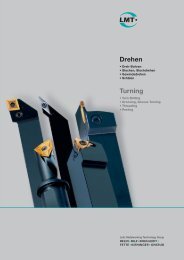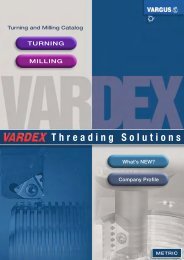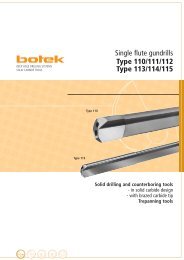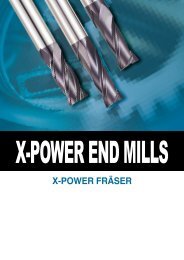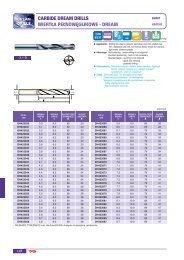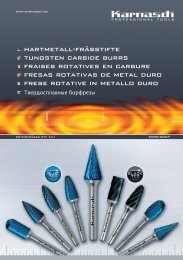Gear Cutting Tools
Hobs - Torion
Hobs - Torion
- No tags were found...
Create successful ePaper yourself
Turn your PDF publications into a flip-book with our unique Google optimized e-Paper software.
Carbide types and<br />
coatings<br />
The carbide types generally used<br />
are those of the main machining<br />
groups K and P. The types present<br />
advantages and disadvantages<br />
according to their material composition<br />
(alloying elements and components)<br />
and their grain size.<br />
Whereas K carbides, owing to the<br />
tendency of chips to bond to the<br />
uncoated substrate, can only be<br />
employed fully coated, P carbides<br />
can also be employed in uncoated<br />
form. There is therefore no need<br />
for the cutting face to be re-coated<br />
following regrinding. This reduces<br />
the maintenance costs for P carbide<br />
hobs considerably.<br />
In addition, P carbides are less<br />
sensitive to temperature, and the<br />
strong progressive increase in<br />
wear which takes effect from a<br />
flank wear of approximately 0.2<br />
mm onwards is considerably lower.<br />
The substrate reacts more favourably.<br />
By contrast, fine-grain carbides<br />
have as yet only been developed<br />
for the K types. Fine-grain carbides<br />
permit very high hardness<br />
values and consequently a high resistance<br />
to wear, combined with<br />
excellent toughness.<br />
Consequently, fully coated K substrates<br />
generally permit higher tool<br />
life qualities when compared with<br />
hobs manufactured from P carbides,<br />
which lose their cutting face<br />
coatings at the first regrind at the<br />
latest. P carbide hobs must therefore<br />
be changed more frequently.<br />
TiN, manufactured by means of<br />
PVD, continues to be the main<br />
substance employed for the hard<br />
material layer of hobs. TiN possesses<br />
excellent chemical resistance<br />
to the hot steel chips. In addition<br />
to its hardness of 2200 HV,<br />
its relatively high toughness makes<br />
it particularly attractive for hobs.<br />
The logistics aspect represents a<br />
decisive advantage. TiN is the<br />
coating which, owing to its low<br />
pressure characteristics, can be<br />
re-coated more easily. This is essential<br />
following grinding of the<br />
cutting face of hobs with a K type<br />
substrate.<br />
Newly developed coatings such as<br />
TiCN and (TiAIN)<br />
can attain longer tool life travel for<br />
a given application, but have yet to<br />
be accepted by the market, particularly<br />
with regard to the re-coating<br />
aspect.<br />
Advantages:<br />
Disadvantages:<br />
● Re-coating not necessary following regrinding<br />
● Low maintenance costs (regrinding only)<br />
● Shorter tool life in the reground condition, therefore:<br />
● More frequent tool changes required<br />
● Shorter maintenance times, consequently:<br />
● Fewer tools in circulation (lower capital investment)<br />
● Lower progressive rise in wear when the coating is penetrated,<br />
consequently:<br />
● Lower risk of built-up edges<br />
Use of coated solid carbide hobs with P type substrate<br />
Maintenance process: regrinding (flank coated, cutting face uncoated)<br />
Advantages:<br />
Disadvantages:<br />
● Generally longer tool life, therefore:<br />
● Less frequent tool changing<br />
● Fine-grain grades possible, therefore:<br />
● Greater toughness and greater hardness<br />
● Cannot be employed uncoated, i.e. removal of the coating and<br />
re-coating is required, therefore:<br />
● Higher maintenance costs<br />
● Longer maintenance times, therefore:<br />
● More tools in circulation (greater capital investment)<br />
● Strongly progressive increase in wear following penetration of<br />
the coating, consequently:<br />
● Greater risk of built-up edges<br />
Use of coated solid carbide hobs with K type substrate<br />
Maintenance process: removal of coating - regrinding - re-coating (flank and cutting face coated)<br />
27



